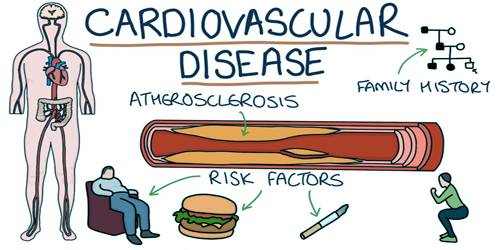Cardiovascular disease is a common term used to describe various disorders that affect the heart. CVD includes coronary artery disease (CAD) such as angina and myocardial infarction (commonly known as a heart attack). Cardiovascular disease, also known as heart disease, is one of the leading causes of death among men and women in the United States. Other CVDs include stroke, heart failure, hypertensive heart disease, rheumatic heart disease, cardiomyopathy, abnormal heart rhythm, congenital heart disease, valvular heart disease, carditis, aortic aneurysm, thromboembolic thromboembolism, and thromboembolic thrombosis.
The term cardiovascular disease includes diseases of the blood vessels including coronary artery disease; Heart rhythm problems, or arrhythmia; Heart infection; And congenital heart defects. Narrowing of blood vessels is a common form of heart disease. Coronary artery disease, stroke, and peripheral artery disease are involved in atherosclerosis. This may be due to high blood pressure, smoking, diabetes mellitus, lack of exercise, obesity, high blood cholesterol, low diet, and excess alcohol consumption. In comparison, heart disease is more specific and refers only to cardiovascular diseases such as coronary artery disease, heart failure, abnormalities of the heart valves and abnormal rhythms of the heart. Hypertension CVD accounts for about 13% of deaths, while tobacco accounts for 9%, diabetes 6%, lack of exercise 6% and obesity 5%. Rheumatic heart disease can follow the strep throat without treatment.
But in most cases, the term cardiovascular disease refers to the consequences of atherosclerosis, also known as hardening of the arteries. It is estimated that up to 90% of CVD can be preventable. The prevention of CVD includes improving risk factors: eating healthy, practicing, avoiding tobacco smoke, and limiting alcohol intake. The onset of symptoms or symptoms of atherosclerosis begins several years ago. Cholesterol-rich fat deposits accumulate inside the artery walls. The treatment of risk factors such as high blood pressure, blood lipids and diabetes is also useful. Treating people with strep throat with antibiotics can reduce the risk of arthritis.
Congenital heart disease is the structure and function of the heart that is a problem present at birth. CVD together resulted in 17.9 million deaths (32.1%) in 2015, while in 1990 it was 12.3 million (25.8%) CVD has declined in the most developed world since the 1970s. In order to encourage early detection, diagnosis, and intervention for therapeutic conditions such as heart disease, people with 45-99 years of age are at risk for chronic disease, 75 years of age or older, and health assessment items for Aboriginal and Torres are also available on Street Islands people. Coronary artery disease and stroke account for 80% of CVD in men and 75% of CVD in women. Significant investment in CVD research through the National Health and Treatment Research Council (NHMRC), with a focus on investigating the causes, effects, effects, and complications of CVD. In the United States, 11% of people between the ages of 20 and 40 have CVD, 37% between 40 and 60, 71% of people in the ’80s, and CVD in people over 80. Additionally, the Australian Health and Welfare Institute is funded to support national surveillance and monitoring of vascular diseases, including CVD, diabetes, and chronic kidney disease, to help reduce the health, social and economic burden of these diseases. This diagnosis is usually seen in men seven to ten years earlier than women.
















